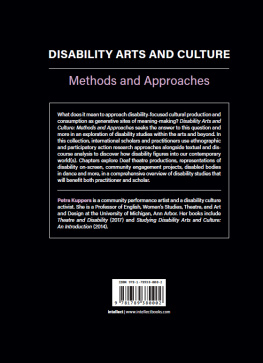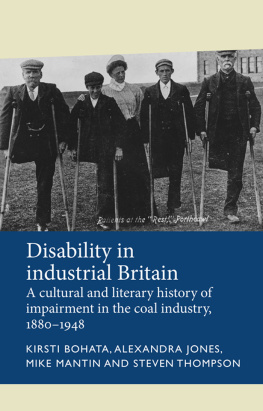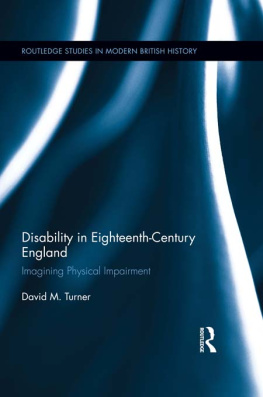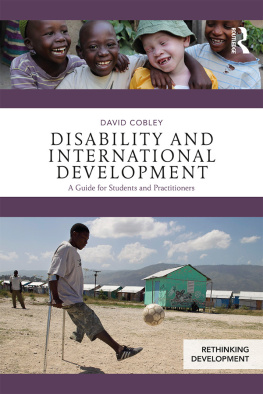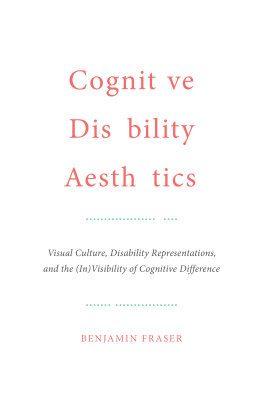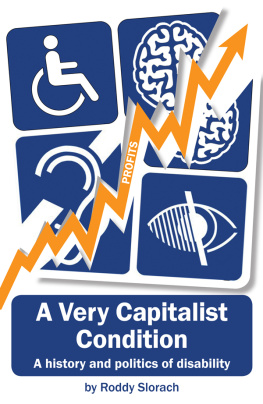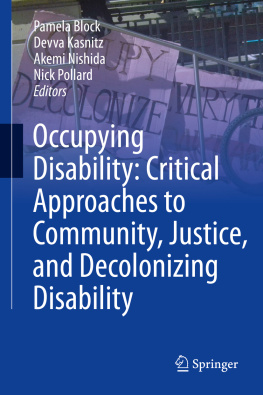Contents
Figures


First published in the UK in 2019 by
Intellect, The Mill, Parnall Road, Fishponds, Bristol, BS16 3JG, UK
First published in the USA in 2019 by
Intellect, The University of Chicago Press, 1427 E. 60th Street, Chicago, IL 60637, USA
Copyright 2019 Intellect Ltd
All rights reserved. No part of this publication may be reproduced, stored in a retrieval system, or transmitted, in any form or by any means, electronic, mechanical, photocopying, recording, or otherwise, without written permission.
A catalogue record for this book is available from the British Library.
Copy-editor: MPS Technologies
Cover designer: Aleksandra Szumlas
Cover image: Nobuhiro and Juri in the Thikwa plus Junkan Project Japan Premiere, Art Theater dB Kobe, Photo: Toshie Kusamoto.
A small person with glasses and grey-black hair in a purple shirt navigates their wheelchair carefully around another person lying prone on a stage. Light reflects off a black wheelchair wheel cantered into the space. An audience looks on.
Production editors: Katie Evans and Jelena Stanovnik
Typesetting: Contentra Technologies
Print ISBN: 978-1-78938-000-2
ePDF ISBN: 978-1-78938-000-6
ePub ISBN: 978-1-78938-001-9
Printed and bound by Short Run Press, UK.
This is a peer-reviewed publication.

This work is licensed under the Creative Commons Attribution Non Commercial No Derivatives (CC BY-NC-ND) Licence. To view a copy of the licence, visit https://creativecommons.org/licenses/by-nc-nd/4.0/
Petra Kuppers
W elcome to this collection of essays on contemporary disability arts and culture. The material collected here showcases a rich range of different methods for garnering insights into connections between disability and contemporary culture. The essays authors have moved far away from understanding disability as a tragedy or a deficit. Instead, they embrace a perspective on disability as a mode of living that is or is not supported in a particular cultural arrangement, with culturally specific effects on the personal and the social level. Disability emerges not only as a whole way of life and as ordinary, grounded in lived reality (to cite two meanings of Raymond Williamss foundational keyword on culture, 1983). Disability also becomes a complex cultural concept that allows researchers to reflect on intercultural nets, on sustainability and community, on rupture and difference. In this way of understanding disability, it is part of a journey of embodiment and enmindment (a term that captures the process-based character of culturally shaped cognitive and mental life). Researchers can investigate both how popular cultural practices shape these ways of being and how in turn disabled culture activists perform, play with or subvert wider culture(s).
In these essays, disabled people are culture makers and artists, and they have agency in the ways in which they engage wider cultural narratives. This assertion links disability cultural studies to insights from other liberatory cultural studies, for example Jane Radways feminist work on investigating womens agency in popular pleasures and the consumption of patriarchal narratives in pulp romance (1984), or Frantz Fanons investigations of black phenomenology, life under colonial racism (1991).
In this collection, disabled people are initiators, collaborators, sometimes clients and participants, but always in active roles that demand ethical engagement with what it means to be disabled, precarious, vulnerable or dismissible in a particular society. How to navigate relative power, how to address medical narratives, how to consume and produce material while living under pressures of gazes, stereotypes and old stories: these are the questions that underpin the material here. In order to find answers, the contributors use textual analysis; discourse analysis; qualitative methods including interviews, ethnographies and arts-based approaches. These overlapping and intertwining methods provide the organizing framework of this collection, and the subheading under which all contributions are arrayed, even while many essays engage more than one of these methods.
This collection emerged from five years worth of Intellects publishing archives, and a good trawl of the publishing companys journal back issues. When invited to edit a collection out of this material, the wealth of material I found was astonishing and an excellent testimony to the vibrancy of contemporary disability arts and culture research. I particularly gravitated towards approaches emerging from ethnomethodology and participatory action research methods, i.e., methods that ensure reflections on power relations and goal setting in research. I did not include contributions focused primarily on historical research methods, as these tend to be well represented in the field generally, in many different national contexts.
Another inclusion criteria was international scope. In a rich, but demarcated pool of options, I focused on a balanced perspective between material generated from the United Kingdom and the United States, historical birth places for highly influential disability culture research production where disability studies have become a relatively mainstream academic endeavour, and other nations and regions with their own historically grounded approaches.
Different national disability studies, and disability arts and culture research, have different origin narratives, connections to activism and embedments in social and humanities approaches. In order to honour these diversities, I chose not to create a citational and definitional framing in this introduction. Rather than track particular developments and language uses, I point to the citational webs the individual authors provide, for their perspectives on important genealogies for their particular projects, grounded in different disciplines and national frameworks. I invite readers of this collection to compare different contributions citational webs.
By pointing to this kind of anti-hegemonic decision-making, I also invite future researchers to think through their own politics of citation, to not rest too easily in any one particular lineage for their work, and to stay curious about a particular terms origins. In this relatively young discipline pool, it is possible to be strategic in ones choices, and to shape origin stories that reflect the world we want to live in: one that aggregates its narratives from multiple perspectives and experiences.
In order to illustrate the opportunities inherent in thinking creatively about methods of gaining and aggregating knowledge, this introduction offers a case study to open up questions. I look at a cultural form that spans popular culture and experimental art: puppets and puppet making. Three different examples, from popular culture to art experimentation, highlight different avenues of knowledge production.
Methods of knowledge creation: Puppet shows
The first case study focuses on cultural production methods. In 2016, Sesame Street, the long-running childrens TV series based in the United States and syndicated world-wide, started a research project on autism representation. This resulted in the first introduction of a new puppet in a decade. The show welcomed Julia, an autistic muppet, an adorable little girl with yellow skin and orange hair whose behaviour follows non-normative scripts.

